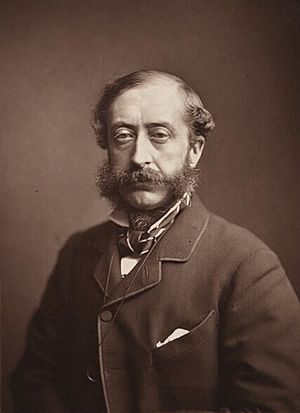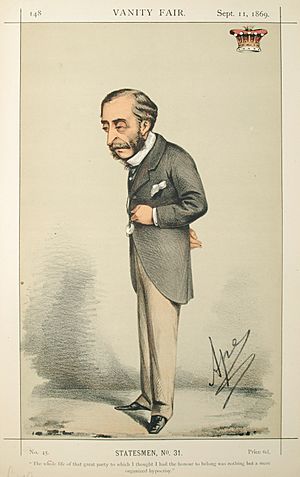Henry Herbert, 4th Earl of Carnarvon facts for kids
Quick facts for kids
The Earl of Carnarvon
|
|
|---|---|

The 4th Earl of Carnarvon, c. 1881
|
|
| Lord Lieutenant of Hampshire | |
| In office 6 August 1887 – 29 June 1890 |
|
| Monarch | Victoria |
| Preceded by | The Marquess of Winchester |
| Succeeded by | The Earl of Northbrook |
| Secretary of State for the Colonies | |
| In office 6 July 1866 – 8 March 1867 |
|
| Monarch | Queen Victoria |
| Prime Minister | The Earl of Derby |
| Preceded by | Edward Cardwell |
| Succeeded by | The Duke of Buckingham and Chandos |
| In office 21 February 1874 – 4 February 1878 |
|
| Monarch | Queen Victoria |
| Prime Minister | Benjamin Disraeli |
| Preceded by | The Earl of Kimberley |
| Succeeded by | Sir Michael Hicks Beach, Bt |
| Lord Lieutenant of Ireland | |
| In office 27 June 1885 – 28 January 1886 |
|
| Monarch | Queen Victoria |
| Prime Minister | The Marquess of Salisbury |
| Preceded by | The Earl Spencer |
| Succeeded by | The Earl of Aberdeen |
| Personal details | |
| Born | 24 June 1831 Grosvenor Square, London |
| Died | 29 June 1890 (aged 59) Portman Square, London |
| Nationality | English |
| Political party | Conservative |
| Spouses |
Lady Evelyn Stanhope
(m. 1861; died 1875)Elizabeth Howard
(m. 1878) |
| Children |
|
| Parents | Henry Herbert, 3rd Earl of Carnarvon Henrietta Anna Howard |
| Alma mater | Christ Church, Oxford |
Henry Howard Molyneux Herbert, 4th Earl of Carnarvon (born June 24, 1831 – died June 29, 1890), was an important British politician. He was a leading member of the Conservative Party. He held a very important job twice: Secretary of State for the Colonies. This role meant he was in charge of managing Britain's colonies around the world. He also served as Lord Lieutenant of Ireland, which was the Queen's representative in Ireland.
Contents
Early Life and Education
Henry Herbert was born in London in 1831. His father was the 3rd Earl of Carnarvon. When Henry was 18, his father passed away, and he became the 4th Earl of Carnarvon.
He went to Eton College, a famous school. Later, he studied at Christ Church, Oxford University. At Oxford, he was known as "Twitters" because he sometimes had nervous movements. He was a very good student and graduated with top honors in 1852.
Starting a Political Career
Carnarvon began his political journey in 1854. He gave his first speech in the House of Lords, which is part of the British Parliament. He quickly rose through the ranks.
From 1858 to 1859, when he was only 26, he worked as the Under-Secretary of State for the Colonies. This was his first experience helping to manage Britain's colonies.
Improving Prisons in Britain
In 1863, Carnarvon became very interested in making prisons better. He visited many jails and saw that conditions needed to improve. He believed that prisons should be tougher, with stricter rules for work and food. He also wanted all prisons across the country to follow the same rules.
He led a special committee in the House of Lords to study this. Their ideas helped create the Prisons Act 1866. This law made many of Carnarvon's ideas about prison reform a reality.
Colonial Secretary: First Term (1866–1867)
In 1866, Carnarvon was given a very important job: Secretary of State for the Colonies. In this role, he was responsible for all of Britain's colonies.
One of his biggest achievements during this time was introducing the British North America Act 1867. This act was super important because it gave Canada self-government and created the country as a federation. A federation means different parts (like provinces) join together to form one country, but they still have some of their own powers.
Later in 1867, he resigned from his job. He disagreed with a new law proposed by Prime Minister Benjamin Disraeli that would give more working-class people the right to vote.
Colonial Secretary: Second Term (1874–1878)
Carnarvon returned as Colonial Secretary in 1874. He worked to solve a disagreement between British Columbia and Canada. British Columbia had been promised a railway link to the rest of Canada. Carnarvon proposed a plan, known as the "Carnarvon terms," to make sure this railway was built.
Plans for South Africa
During this second term, Carnarvon also tried to unite the different states in Southern Africa into a single confederation under British rule. He believed this would help with "imperial defence," meaning protecting Britain's interests and naval bases in the region.
However, this plan was very unpopular with the people and leaders in Southern Africa. Many states were independent and did not want to be forced into a confederation. The Prime Minister of the Cape Colony, a large and important state, said that forcing this idea would lead to conflict. They also worried it would harm the rights of Black citizens if they joined with less liberal states.
Carnarvon sent British officials to Southern Africa to try and make his plan happen. This led to several wars, including the Anglo-Zulu War and the First Boer War. These conflicts caused a lot of problems and suffering.
The idea of confederation was eventually dropped when Carnarvon resigned in 1878. He left his job because he disagreed with the Prime Minister's approach to another international issue, the "Eastern Question." The wars caused by his South Africa policy continued, leading to more conflicts later on.
Lord Lieutenant of Ireland (1885–1886)
In 1885, Carnarvon became the Lord Lieutenant of Ireland. This was the Queen's main representative in Ireland. His time in this role was short. He was involved in discussions about "Home Rule" for Ireland, which meant giving Ireland more control over its own affairs. He resigned again in 1886 and never held another government office.
Other Important Roles
Lord Carnarvon held many other important positions. He was the Lord Lieutenant of Hampshire, a ceremonial role in a county in England. He was also a Deputy Lieutenant of Nottinghamshire.
He was known as a very educated person. He was a president and a fellow of the Society of Antiquaries of London, a group that studies history and old objects. He was also a Fellow of the Royal Society, which is a group for top scientists. He was also a prominent freemason, a member of a social and charitable organization.
Buildings and Interests
Lord Carnarvon was interested in new ideas and building. He oversaw changes to his family home, Highclere Castle, which is now famous from the TV show Downton Abbey. He also had special "Concrete Cottages" built in Old Burghclere around 1870. These were early examples of houses made from concrete, showing his interest in new building methods for workers' homes.
He also owned a large villa in Italy called Villa Altachiara, which means "Highclere" in Italian.
Family Life
Lord Carnarvon was married twice. His first wife was Lady Evelyn Stanhope. They had one son and three daughters:
- George Herbert, 5th Earl of Carnarvon (1866–1923), who later became famous for helping to fund the discovery of Tutankhamun's tomb in Egypt.
- Lady Winifred Herbert
- Lady Margaret Herbert
- Lady Victoria Herbert
After his first wife passed away in 1875, he married his cousin, Elizabeth Catherine Howard, in 1878. With his second wife, he had two more sons:
- Hon. Aubrey Nigel Henry Molyneux Herbert (1880–1923), who was a soldier, diplomat, and politician.
- Hon. Mervyn Robert Howard Molyneux Herbert (1882–1929), a diplomat and cricketer.
Death
Lord Carnarvon passed away in June 1890, at the age of 59, in London.
Images for kids




